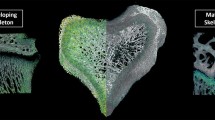Abstract
Two iliac crest needle biopsies were taken from a 43-year-old lead-poisoned woman during and after completion of a Ca-EDTA treatment. By atomic absorption spectroscopy the first and second biopsy were found to contain 56, respectively 41.6 μg lead/g wet tissue. In both biopsies 36% of the lead was extractable in 0.1 N HCl. Electron microbeam X-ray analysis proved to have too low sensitivity for quantitation of the lead in these biopsies. Laser microbeam mass analysis (LAMMA), performed only on the second biopsy, revealed a high and fairly constant residual lead concentration in all bone marrow cell nuclei (approximately 55 μg/g) and a low lead concentration in the cytoplasm of the same cells (4–12 (μg/g). The extracellular bone matrix lead was greatly concentrated in the superficial 3–6 μm osteoid zone of the bony trabeculae and totally absent from deeper parts of the mineralized matrix. The LAMMA results are in good agreement with those of subcellular fractionation experiments and atomic absorption spectroscopy, provided that the relative volume fraction of nucleus and cytoplasm is accounted for. The high residual osteoid lead after completed chelation therapy indicates that lead has a stronger affinity for the organic than the mineral components of bone matrix.
Similar content being viewed by others
References
Barltrop D, Barrett AJ, Dingle JT (1971) Subcellular distribution of lead in the rat. J Lab Clin Med 77: 705–712
Blackman SS Jr (1936) Intranuclear inclusion bodies in the kidney and liver caused by lead poisoning. Bull John Hopkins Hosp 58: 384–403
Bolender RP, Weibel ER (1973) A morphometric study of the removal of phenobarbital-induced membranes from hepatocytes after cessation of treatment. J Cell Biol 56: 746–761
Castellino N, Aloj S (1965) Effects of calcium sodium ethylenediamine tetraacetate on the kinetics of distribution and excretion of lead in the rat. Br J Industr Med 22: 172–180
Castellino N, Aloj S (1969) Intracellular distribution of lead in the liver and kidney of the rat. Br J Industr Med 26: 139–143
Finner LL, Calvery HO (1939) Pathological changes in rats and dogs fed diets containing lead and arsenic compounds. Arch Pathol 27: 433
Frost HM (1962) Tetracycline labelling of bone and the zone of demarcation of osteoid seams. Can J Biochem 40: 485–489
Goyer RA, May P, Cates MM, Krigman MR (1970) Lead and protein content of isolated intranuclear inclusion bodies from kidneys of lead-poisoned rats. Lab Invest 22: 245–251
Grandjean P (1984) Lead poisoning: hair analysis shows the calendar of events. Hum Toxicol 3: 223–228
Gross SB, Pfitzer EA, Yeager DW, Kehoe RA (1975) Lead in human tissues. Toxicol Appl Pharmacol 32: 638–651
Hammond PB (1971) The effect of chelating agents on the tissue distribution of lead. Toxicol Appl Pharmacol 18: 196–310
Hayat MA (1981) Fixation for electron microscopy. Academic Press, New York
Johnson LC (1964) Morphological analysis in pathology. The kinetics of disease and general biology of bone. In: Frost HM (ed) Bone biodynamics. Little, Brown & Co., Boston, pp 543–645
Kahn HE, Pederson GE, Schallis JE (1968) Atomic absorption microsampling with the sampling boat technique. Atomic Absorption Newsletter 7: 35–39
Knese KH (1979) Stützgewebe und Skelettsystem. Handbuch der mikroskopischen Anatomie des Menschen, vol. 2, part 5. Springer Verlag, Berlin
Larsen L (1975) The ultrastructure of the developing proximal tubule in the rat kidney. J Ultrastruct Res 51: 119–139
Moore JF, Goyer RA, Wilson M (1973) Lead-induced inclusion bodies. Solubility, amino acid content, and relationship to residual acidic nuclear proteins. Lab Invest 29: 488–494
Muro LA, Goyer RA, Hill C (1969) Chromosome damage in experimental lead poisoning. Arch Pathol 87: 660–663
Nash WW, Poor BW, Jenkins KD (1981) The uptake and subcellular distribution of lead in developing sea urchin embryos. Comp Biochem Physiol 69 C: 205–211
Prerovska T, Teisinger J (1970) Excretion of lead and its biological activity severeal years after termination of exposure. Br J Industr Med 27: 352–355
Sabbioni E, Marafante E (1976) Identification of lead binding components in rat liver: in vivo study. Chem Biol Interact 15: 1–20
Schmidt PF, Flood PR (1984) Lokalisation von Spurenelementen im menschlichen Gewebe mit Hilfe der Laser-MikrosondenMassen-Analyse. In: Zumkley H (eded) Spurenelemente in der inneren Medizin unter besonderer Berücksichtigung von Zink. Innovations Verlagsgesellschaft, Seeheim-Jugenheim, pp 22–36
Schmidt PF, Fromme GH, Pfefferkorn G (1980) LAMMA-investigations of biological and medical specimens. Scanning Electron Microscopy II: 625–634
Schmidt PF, Ilsemann K (1984) Quantitation of LAMMA results by the use of organic mass peaks for internal standards. Scanning Electron Microscopy I: 77–85
Weibel ER, Staubli W, Gnagi HR, Hess FA (1969) Correlated morphometric and biochemical studies on the liver cell. J Cell Biol 42: 68–112
Wesenberg GBR, Fosse G, Justesen N-PB, Rasmussen P (1978) Lead and cadmium in teeth, bone and kidneys of rats with a standard Pb-Cd supply. Int J Environ Stud 24: 223–230
Author information
Authors and Affiliations
Rights and permissions
About this article
Cite this article
Flood, P.R., Schmidt, P.F., Wesenberg, G.R. et al. The distribution of lead in human hemopoietic tissue and spongy bone after lead poisoning and Ca-EDTA chelation therapy. Arch Toxicol 62, 295–300 (1988). https://doi.org/10.1007/BF00332490
Received:
Revised:
Accepted:
Issue Date:
DOI: https://doi.org/10.1007/BF00332490




